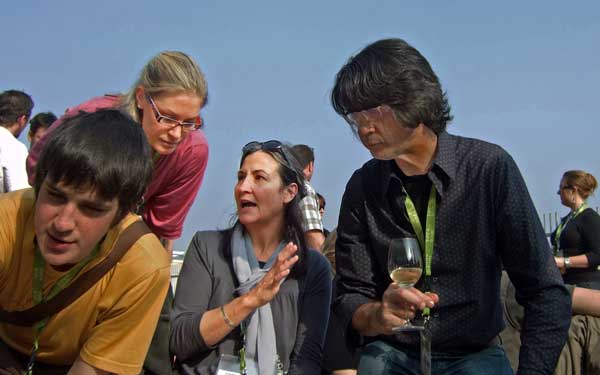

Though some spring days are terrific; working the soil before it has dried is about the worst thing a farmer can do. This would be a good time to:
Submit an application for a Premier’s Award. Farmers and food processors are always innovating. This might be a response to consumer demand, an improved business practice, educating the public, or enhancing environmental stewardship. If you wish to share an innovation, you may be eligible for a $5,000 to $75,000 Agri-Food Innovation Award. Submissions are due by April 10, 2015. This site links to descriptions of the innovations by previous winners. (You probably know some of them.)
Speak with a neighbour about sharing land. Ruth Knight, principle of Organic [Soil] Consultant (519-357-5224), recently sponsored a workshop with Holistic Management Trainer Joshua Dukart. He described some successful land exchanges between farmers. Soil remediation occurs when the arrangement integrates multi-species cover-crops and/or grazing into their separate operations. If you don’t have sufficient land to follow the rotations you know you should, this could become a mutually beneficial community-building solution.
Speculate on Jerusalem Artichokes. This prolific crop has few pests and thrives on marginal soils. I regularly hear about buyers searching for tons of them. Their roots and stems have a special inulin that can be easily converted into a wide variety of useful products: ethanol, soluble fiber prebiotic, weight-loss filler, gluten-free flour, non-GMO sugar, organic fructose [sounds like an oxymoron], alcohol, pet food, a pharmaceutical excipient, bio-plastic feedstock, renewable jet fuel [Henry Ford powered his first cars with artichokes], and airplane deicer. On the farm they are easily grown organically, effectively smother weeds, boost soil organic matter, are perennial, and both the forage and tubers are registered animal feed. Since it is reproduced vegetatively (not by seeds), multi-national corporations are not interested in this crop because it would be too difficult to control. But this is exactly what can make it of interest to small farmers. Seed tuber production would become lucrative when any of the potential uses takes off. I am not promoting this as a pyramid scheme; but [full disclosure] this has been offered in the past.
Consider altering your business model. Set aside some time in your favourite creative setting to revel in the return of songbirds and to reevaluate what you are doing. This might be the year to:
I can help you confirm the benefits of such changes by developing a Feasibility Plan.

A positive result of the Ontario Premier assuming the Minister of Agriculture portfolio is that she now understands that agriculture contributes even more to the economy (GDP) than the numbers show.
Farmers simply borrow (don’t consume) some soil, recycle some water, capture a bit of sunlight, and transform some air. All these are “free” resources. From the dollar-economy, farmers use some labour and small amounts of seeds, fuel, and supplies. Magically, from very few nonrenewable resources, they create something of great dollar value.
By most measurements, the agri-food industry is already the largest segment of the Ontario economy. If we did not relinquish the opportunity to further benefit from this industry (by using imports), the overall economy could benefit even more. China and the U.S. are not foolish to sell us cheap food; it is we who are foolish to buy it.
The Premier’s target to increase agriculture and food employment by 120,000 (+16% by 2020) is both sensible and feasible. The sector would then contribute an impressive $40-billion to the Ontario economy. The recent Southern Ontario Food System Report produced by the McConnell, Metcalf and Greenbelt Foundations estimates that half of the $20-billion in imported food could be produced locally. But all this growth is going to take additional trained farmers with access to good farmland. This is a terrific time to invest in agriculture by ending the rapid loss of farmers and farmland.
A widely recognized tenet of pest control is to use rotations to reduce pest resistance. The current practice of routinely using seeds treated with neonicotinoids is already resulting in pest resistance. This is unacceptable stewardship! If you care about food and ecology, please join the growing chorus speaking up to stop this madness.
The “cheap and profitable food” segment of agriculture is gearing up to fight Ontario’s proposed new regulations on the use of neonicotinoids. These “neonics” are a family of systemic insecticides (which means you can’t wash them off) that have been designed to kill insects. And they do kill pests very effectively! But they also kill pollinator, predator, and non-target insects (i.e. bees, pirate bugs, and monarchs). With few survivors, insect-eating birds are no longer thriving. Water-soluble neonics flow into waterways where they also kill invertebrates (frogs). And most frightening of all, it appears they also kill small mammals.
This class of insecticide was first patented in 1985. By the late 90’s this “miracle” insecticide was becoming widely used. Within a decade, environmental impacts (similar to DDT) were being observed (and routinely dismissed). Germany started to regulate neonic use in 2009; followed by the entire European Union in 2013. Ontario is scheduled to become the first North American jurisdiction to do so in July 2015.
2013 data shows that 95% of corn is treated with neonics. The majority of apples, oranges, berries, leafy greens, tomatoes, potatoes, grains, nuts, and wine grapes are now being treated with some form of this chemical. Even spring bedding plants used in home gardens are routinely treated. 50% of soybeans are treated, but it is generally conceded that this provides no benefit. Your surest protection from this pernicious chemical is choosing Organically grown food.
As a careful observer of nature, I notice that weeds, insects and diseases are nature’s agents for healing the earth. If a particular pest becomes too troublesome to me as a farmer, I can come up with a way to control it. But I have to keep in mind that in doing this, I must assume the job that this “pest” was donating. So I have to be very careful what I wish for. If I fail to do its job well, even more severe problems will arise.

Pamela Cuthbert was a generous writer and leader in the movement toward more locally grown and good tasting foods. She founded the Toronto Slow Food Convivium, which she encouraged me to join. This became so rewarding that I later joined the Steering Committee. She also assured me that the Italian government’s invitation to the 2004 Slow Food Terra Madre with 5,000 farmers from 130 countries was no hoax. It was one of my most inspirational weeks. More recently Pam has been the Program Curator for the Terroir Hospitality Symposium. She contributed to bringing many of the world’s foremost good food pioneers to share their insights with members of the Toronto hospitality community. She was in the midst of finalizing the 2015 edition when Pam suddenly passed away. We will miss her.
Members of the hospitality industry should plan to attend Terroir on May 11th.
| forward to a friend and suggest signing up to receive this newsletter every month. |